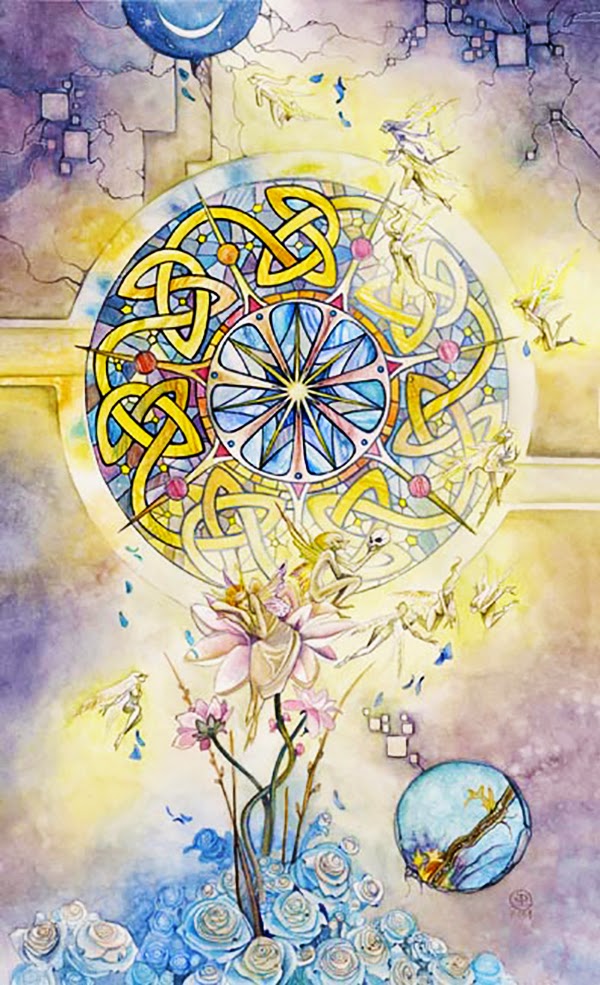The Wheel of Fortune Tarot
Affirmation: I am in the center of the wheel of change, the hub of whatever spins around me.
Tarot Card Meaning: Plan or Destiny, the weaving of life's threads coming together, fate, turning points, movement and change, patterns and cycles, an interconnected world. The hub of synchronicity.
In the center of the wheel look for hidden knots that connect the world together. The Wheel symbolizes time and its mysteries.So while riding the wheel of destiny, make sure it a good one, seize the opportunities as you pass them by, learn and grow, take risks if need be, and embrace good luck and bad luck at the same time.
The Wheel of the Year
The Wheel of the Year is an annual cycle of seasonal festivals, observed by many modern Pagans. It consists of either four or eight festivals: either the solstices and equinoxes, known as the "quarter days", or the four midpoints between, known as the "cross quarter days"; syncretic traditions like Wicca often celebrate all eight festivals.
The festivals celebrated by differing sects of modern Paganism can vary considerably in name and date. Observing the cycle of the seasons has been important to many people, both ancient and modern, and many contemporary Pagan festivals are based to varying degrees on folk traditions.[1]
Among Wiccans, the festivals are also referred to as sabbats /ˈsæbət/, with Gerald Gardner claiming this term was passed down from the Middle Ages, when the terminology for Jewish Shabbats was commingled with that of other heretical celebrations. See Witches' Sabbath http://en.wikipedia.org/wiki/Wheel_of_the_Year
Basing itself on this deep and mysterious connection between the Source of our individual lives and the source of the life of the planet, Druidry recognises eight particular times during the yearly cycle which are significant and which are marked by eight special festivals.
Of these eight times, four are solar and four are lunar - creating thereby a balanced scheme of interlocking masculine and feminine observances. The solar observances are the ones that most people associate with modern-day Druids - particularly the Summer Solstice ceremonies at Stonehenge.
The Wheel of Life
The bhavacakra (Sanskrit; Pali: bhavacakka; Tibetan: srid pa'i 'khor lo) is a symbolic representation of samsara (or cyclic existence) found on the outside walls of Tibetan Buddhist temples and monasteries in the Indo-Tibetan region. In the Mahayana Buddhist tradition, it is believed that the drawing was designed by the Buddha himself in order to help ordinary people understand the Buddhist teachings.
The bhavacakra is popularly referred to as the wheel of life. This term is also translated as wheel of cyclic existence or wheel of becoming. http://en.wikipedia.org/wiki/Bhavacakra
The Wheel of Life describes the cause of all evil and its effects, mirrored in earthly phenomena just as it is experienced by everyone from the cradle to the grave. Picture by picture it reminds us that everyone is always his or her own judge and responsible for their own fate, because, according to Karma, causes and their effects are the fruits of one's own deeds.
The circular composition of the Wheel of Life guides the viewer from picture to picture along the black path or the white path. It leads one through the twelve interwoven causes and their consequences to rebirth in one of the so-called Six Worlds. Projected on one plane, they fill the whole inner sphere the Wheel of Life. The meaning of this is to show the way out of all these worlds of suffering into the sphere beyond.http://www.buddhanet.net/wheel1.htm













0 comments :
Post a Comment